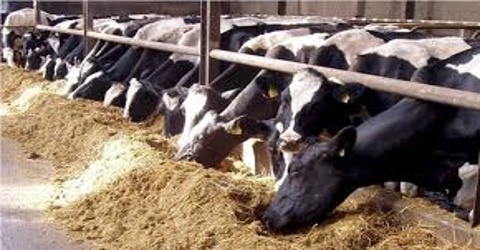The principle objective of this report is to analysis the Role of Dairy Farm in livestock Sector of Bangladesh. General objectives of this report are to observe the present condition of dairy farm and its production, investigate the relationship of people of different profession with the dairy farm, investigate about the diseases, rate of death, vaccine and treatment facilities of the dairy farm. Finally determine the source of money to establish dairy farm and to demonstrate the present situation of knowledge and training associate with the dairy farm.
Statement of the problem:
In agricultural economy, production management, employment of huge people, poverty reduction and animal protein supply, livestock sector plays very crucial role. But expected development of this sector is not occurred because government did not give appropriate priority to this sector. Now the production of this sector among the total production of the country is only 3%. Contribution of this sector in the total production of the country decreasing day after day which is not expected because the foods produced by this sector has a great demand in this country and this industry has a lot of prospect.
In 1998, there were existence of 30,000 duck farms, 61,000 poultry farms and 30,000 dairy farms in Bangladesh. According to the agricultural census of 1996, the number of cattle, buffalo, goat and ram are almost same from 1983. Per capita it decreases 20 to 30 percent. From 1991 to 2000 the annual growth rate of dairy product, meat and egg are 2.7%, 4.3% and 7.7% respectively. 46% of eggs come from the commercial farm. Major portion of the growth of dairy product is come from the cross breeder cows. 43% cows are cross breeder. Average milk production per week of each dairy farm of Bangladesh is 48 liter.
In private dairy farm of Bangladesh 73% of the dairy farms contain less than 11 cows, 17% of the dairy farms has 11 to 20 cows. It means that most dairy farms in this country are small in size. Only 13% owner of these farm got bank lone to establishing their farm. Rest owner establish their farm with their own capital. Main profession of 45%, 44% and 11% owners are agriculture, business and service respectively.
65% dairy farm are governed by stall feeding system, 30% dairy farm are governed by stall cum open feeding system and the rest 5% dairy farm governed by open feeding system. Farmer on average feed a cow 5.86 kg straw, 9.16 kg green grass and 5.4 kg concentrate food every day. Amount of concentrate food is 26%. Among different diseases, 67% dairy farms affected by diarrhoea, 48.2% dairy farms affected by mastitis and 46.5% dairy farms affected by abort.
Cattle population in Bangladesh is about 24.13 million. In the rural area, cattle are kept mainly for draught purpose. Only a limited number of farmers have cow for milk production. Maximum cattle are no descriptive type, which do not belong to any specific breed and termed as indigenous cattle. These animals are kept mainly in the stall with limited grazing on the roadside; embankment slope, fallow land and paddy straw are their staple food. Husbandry practices and health care of these animals are poor. The average milk production of local cows is very low and it varies between 300 to 400 liters per lactation period of 180 to 240 days. Such low productivity of indigenous cows is an important constraint for future development of the livestock sector. High productive exotic breeds and their crosses normally do not have adequate resistance against the prevalent diseases.
They do not thrive well in our environment. In spite of all these problems, some people have shown interest for development of small dairy farms. Generally crossbred cows under village condition yields 600 to 800 liters if milk per lactation of 210 to 240 days.
Bangladesh suffers from an acute shortage of livestock products like milk, meat and eggs. The domestic demand for milk has been rising faster than the domestic production of milk. Hence Bangladesh Government has given the priority on the development of dairying at farmers level to increase the supply of milk from small dairy farms [10].
Objeectives of the study:
In Dhaka district area, small scale dairy farms have been increasing day by day. People have taken this farming as profitable enterprise. In order to establish future plan for dairy development in this region, it is essential to know details about the management practices and performances of different types of dairy breeds. Thus the study was undertaken with the following objectives.
- To observe the present condition of dairy farm and its production.
- To investigate the relationship of people of different profession with the dairy farm.
- To investigate about the diseases, rate of death, vaccine and treatment facilities of the dairy farm.
- To determine the source of money to establish dairy farm.
- To demonstrate the present situation of knowledge and training associate with the dairy farm.
Definition:
Livestock:
All domestic animal and their productions are called livestock. Contribution of poultry, duck, cattle, buffalo, goat is called the livestock product. In Bangladesh, main contribution of this sector is come from the poultry and dairy farm.
Dairy farm:
Dairy farm is a technique to nurse the cattle under a well-planned house to increase the production of milk and meat.
Present condition of Livestock sector of Bangladesh:
Livestock plays an important role in human civilization. Economic uses of livestock sector is developed with the change of the nature of soil, air and sunlight associate with civilization. Our culture highly appreciated large number of cattle of a farmer and culturally we are very much fond of milk. Demand of this sector increases with increase of population. Density of population is very high in this country and growth rate is still high. This sector can play an important role to fulfill the nutrition demand of this huge population. This sector can solve the unemployment problem of the rural people and can ensure the sustainable multipurpose use of our land. So this sector has the ability to ensure the certain mobility of the economy of Bangladesh through poverty reduction, nutrition supply and employment creation.
Dairy production in Bangladesh:
The Department of Livestock Services (DLS) is the only government department whose responsibility is to motivate and provide extension to livestock-rearing farmers to meet the shortage of animal products (e.g., milk, meat, eggs) as food for the people and also to bring foreign currency to the country. Many policies exist to increase milk production throughout the country, through government dairy farms or private dairy farms. The main objectives of these policies are to distribute raw milk at lower cost and to provide calves at marginal cost to poor farmers interested in rearing dairy animals. The DLS staff also provides other services such as the dispensation of advice on feed, health care, and sometimes medicine[Fo, Sa].
The livestock development strategies in the fifth five-year plan of the Bangladeshi government are to
i) Increase people’s participation through the development of entrepreneurial groups and create new employment opportunities for smallholder farmers, landless laborers, women, and other target groups in livestock development,
ii) Generate income for and alleviate the poverty of rural poor farmers through livestock development,
iii) Increase the supply of milk, meat, eggs, hides and skins, and other animal products through improving breeds, lowering the cost of feed, and improving disease control and
iv) Increase foreign-exchange earning through the export of quality hides and skins and reduce the amount of powdered milk imports [Ba,De].
Milk Producer Cooperatives:
Since 1973, cooperatives of smallholder dairy farmers have existed in Bangladesh, first as a dairy development program, the Co-operative Dairy Complex, with financial assistance from Denmark, and later as the Bangladesh Milk Producers’ Co-operative Union Ltd. (BMPCUL), formed in 1977. The cooperatives market milk and dairy products under the brand name Milk Vita. Today, approximately 40,000 smallholder dairy farmers have become members of primary dairy cooperatives. About 345 of these cooperatives are in existence, covering close to 925 villages in 15 districts of Sirajgonj, Tangail, Manikganj, Takerhat, Baghabarighat, Sree Nagar, Rangpur, Bhairob, and Raipur, supplying over two million liters of milk daily. Farmer members pool their surplus production at the primary dairy cooperative societies, which arrange regular cash payment on the basis of fat content[De,Ja,Sa, Su]. BMPCUL ensures regular collection, processing, and marketing of milk and milk products. The dairy cooperatives also provide necessary support services to farmer members for animal breeding, feeding, health, and training in animal management. In addition, a major part of the surplus earned by the central dairy cooperatives through marketing milk and milk products is paid to the members. Of the total national consumption of 18 million tons per year (t/y) of liquid milk, 15 million are produced domestically. Since 1986, milk production in Bangladesh has increased by 2,635,000 t/y, and imports have decreased by 1,680,000 t/y.
Smallholder Dairy Production:
In 1991, the Bangladeshi government launched a national program to increase milk production rapidly. This program provided subsidies to farmers who were rearing a minimum of five lactating dairy cows, either deshi, crossbred, or exotic. This program was quite successful: milk production greatly increased, money was saved from not having to import so much powdered milk, and more raw milk was available in the markets for people’s consumption. Bangladesh’s indigenous breed of cattle, known as Red Chittagong, is quite suitable for smallholder farmers due to its low feed requirements in comparison with productivity. The Red Chittagongs’ daily milk production averages 4–5 liters, and they calve every year [Sa, St].
Present condition:
Through there are many traditional farms present and expanded still now; many intrinsic and cooperative modern farms in private sector develop in this country. Therefore the production of domestic livestock product such as eggs, milk and meat increases. It saves our foreign currency to reduce the import. Many rural youth people able to be self-employed person by dint of this sector. GDP of this sector increases day by day. 19% product of the agricultural sector comes from this sector.
Types of dairy farm:
There are three types of dairy farm in Bangladesh. These are
- Rural dairies,
- Pocket dairies and
- Metro dairies.
a) Rural dairies:
68% rural people get cattle / buffalo and number of cattle / buffalo per family is 3.5. Among the cattle, 11% are cross breeder and 43% are cows. Number of cows per family in rural area is 1.5 and on average each cow gives 0.8 liter milk per day. On average each family produces 8.3 liters milk in a week [Ba,De].
b) Pocket dairies:
Some places of Bangladesh are known as milk producing area of Bangladesh. Noticeable milk producing areas are Baghabari of Serajgang district, Munshiganj district, Tekerhat of Matharipur district, etc. According to the data collecting from the farmer of Baghabari a farmer able to income 6088.5 taka in a year if he produces paddy. If he planted green grass in place of paddy he can earn 26552. taka in stead of 6088.5 taka if he sales the grass. If he uses these grasses in his dairy farm, he can get 42485 taka and 22 calves in a year, which is very profitable. Milk production and green grass production at Baghabari increases 7 times and16 times respectively within previous 10 years [De,Fo]. 80% cows are cross breeder.
c) Metro dairies:
Metro dairies are developed at the urban areas. Most of them are small in size. All most all farmer byes the total food for their cattle at higher cost but the farming at these areas is still profitable because price of milk and meat in these areas are high. Farmer easily get training, medicine, vaccine, etc compare to the rural people and these farmer are more conscious than the farmer of rural area. 80% cattle are cross breeder. Metro dairies have great opportunity to flourish because it is quite profitable. [St, Su].
The nutritional contributional contribution of dairy milk:
It is well known that milk is an ideal food for humans, particularly to sustain growth in children, fetal growth in pregnant women, and milk production during lactation. It has also been described as nature’s most perfect food. For the newly born infant or animal, mother’s milk is a complete and well-balanced food. Its main constituents, which supply energy and building materials for the young, are accompanied by various nutrients, such as minerals, vitamins, and organic compounds.
Policy issues for future dairy production:
To meet the ever-increasing demand for milk, a sound milk policy should be formulated, with due consideration given to the following points:
1) It should be possible, through breeding by artificial insemination or natural services [De]. To crossbreed indigenous cattle with highyielding bexotic cattle. An ideal dairy cow in the present socioeconomic situation should have a potential of yielding on average 2,500 liters in 290–305 days, with an intercalving period of 13–15 months and age at first calving from 28 to 33 months. The application of improved methods of breeding has greatly increased the productivity of dairy cattle in Bangladesh.
2) The constraint of feeds and fodder is considered the greatest problem facing the development of dairy cattle in Bangladesh.
Due to nonavailability of grazing land, dairy animals will be raised using zero-grazing and factory-type farming techniques. For efficient fodder production, a new national fodder policy should be formulated. Cattle feed mills should be established, and cattle feed should be made available through village markets to the farmers at subsidized rates. Great potential exists for increasing fodder production in both irrigated- and dry-land situations in which a single crop is generally harvested, and short-term leguminous fodder crops could be grown on residual moisture. The use of common grazing lands through the silvipasture system for fodder production also warrants serious attention. Agroforestry plans should incorporate fodder trees and herbs. Modern technologies have been developed for improving the nutritive value of crop residue. A number of nonconventional feeds have to be identified and utilized by the organized compound livestock feed manufacturers. However, very little has been done to inform the farmers as to how to improve the nutritive value of crop residues or use locally available nonconventional feed resources. For example, Urea Molasses Multinutrient Block (UMMB) may be used for better utilization of crop residues, i.e., the rice straw of smallholder farmers at the village level, for their dairy animals.
3) The primary objective of dairy cattle development through smallholders is to achieve greater production of milk and meat. Dairy cattle development can be increased only when an assured guaranteed market or an incentive price for the product will be offered. In Bangladesh the most important factor with an adverse effect on animal production is the lack of a well-organized marketing system, particularly in the case of milk, which is highly perishable. Although there is great demand for such products in urban areas, the supply of these products cannot be ensured without an organized marketing system and transport facilities. As a result, the farmers are deprived of the opportunity to sell their products. To ensure fair prices, an efficient and effective marketing system should be developed.
4) Improvements should be made to communication, power, water supply, and modern storage facilities for dairy products.
5) Smallholder dairy production should also be encouraged at the village level, where roadside grass and rice straw are available.
6). Both the public and the private sectors should introduce ways to make bank credit available to smallholders on easy terms and through simplified procedures.
7) Powdered-milk imports should be reduced to encourage dairying in Bangladesh. National Milk Development Co-operation should be established. For the dairy manufacturing plants, locally made machinery should be available.
Result and discussion:
In this research we mainly deal with the
- Present condition and production of metro dairies of Dhaka city.
- Influence of profession and education of the women to establish dairy farm.
Supplies of input in dairy farm which are
- Food,
- Health management and supply of vaccine and medicine,
- Technology and training,
- Source of capital.
Present condition and production of metro dairies of Dhaka city and its production:
a) Data collecting area:
Data are mainly collected from the Mirpoor and Mathertake region from 30 farmers. Due to lack of time it is not possible to collect data from all area of Dhaka city.
b) Production and reproduction process:
There are many metro dairies in different places at Dhaka city. All are followed stall feeding system. Halim found that 60% farmer followed the stall feeding system. This data differ to our data because we collected data from Dhaka city where open feeding system is not possible he collected his data from the Dhaka district where open feeding system is possible. This results is quite close to our obtain result. 93.3% farms produced only milk. Only 6.7% farmers establish their farms both for milk and meat. Among the respondent, 96.7% breeds their cows by AI process and 3.3% breeds their cows by natural process.
Collected data shows that 73% farms have less than 11 cows, 20% farms have 11-20 cows and 6% farms have more than 20 cows. On average every cow gives 3.55 liter milk per day. Bhuiyan found that on average each cow of the dairy farm gives 3.15 liter milk every day. This result is quite close to our result.
Table – 1: Production systems, purpose of animal rearing and mating system.
| Production system | Purpose of animal rearing | Service | ||||
| Stall feeding | Stall cum open feeding | Open feeding | Milk | Milk + Meat | AI | Natural |
| 30 | 0 | 0 | 28 | 2 | 29 | 1 |
| 100% | 0% | 0% | 93.3% | 6.7% | 96.7% | 3.3% |
Table – 2: Dairy farm size.
| £ 5 no. | 6-10 no. | 11-20 no. | > 20 no. |
| 15 | 7 | 6 | 2 |
| 50% | 23.3% | 20% | 6.7% |
3.2. Influence of profession and education of the farmer in dairy farm industry:
From table-3, it is shown that average family each farmer is 5.89. Educational qualification of 6.7%, 26.7%, 33.3% and 33.3% farmers are up to primary education, up to secondary, higher secondary and higher education respectively. Ali also found that educational qualification of 60% farmer is upto higher secondary level, which is very close to our result. 60% farmers are businessman and 40% farmer are service holder.
Table – 3: Occupation, family size and educational qualification of farm owners.
| Business | Service | Family member | Up to pri. educ. | Up to second. educ. | Hi. second. educ. | Hi. educ. |
| 18 | 12 | 5.89 | 2 | 8 | 10 | 10 |
| 60% | 40% | 6.7% | 26.7% | 33.3% | 33.3% |
Supplies of input in the dairy farm:
In case of dairy farm; food, vaccine, treatment and medicine supply, technology and training, capital, etc are the input. Information about these input from the collected data are given below:
a) Food:
In dairy farm, 70-75% recurring cost is taken for food. On average everyday farmer supplies 5.86 kg straw, 9.16 kg green grass and 5.4 kg concentrate food to each cattle. In a study of Islam it was found that average green grass supplied by a farmer to a cows is 12 kg which is higher that our obtained value because he collected data from the rural area and I have taken my data from Dhaka city. On average each cow able to take 11 kg dry food every day if we consider 15% lose of food. Among the taken dry food, 6.43 kg is fiber type food and 4.57 kg is concentrated food. Most cows are cross breeder. Average weight of each cow is 350 kg. Supplies food is sufficient to produced 3.54 kg milk per cow in every day. But it is impossible to say how much it balances nutrition. Supplies of straw increase with increase of the number of cow. Most farmer bye green grasses. Sarder observed that most farmers planted their green grass in their field which differ to our result because he collected data from Sirajganj district where farmer has available land to cultivate grass.
Table – 4: Average daily feed supply (kg)/cow.
| Dry straw | Green grass | Concentrate |
| 5.86 | 9.16 | 5.4 |
b) Health management, vaccine and medicine supplies:
It is shown that most dairy farms affected by diarrhoea, mastitis, badla, FMD, anthrax, abort and skin diseases. Table – 5 shows that 63.3% dairy farms affected by diarrhoea, 46.7% dairy farms affected by mastitis, 53.3% dairy farms affected by Bloat, 23.3% dairy farms affected by FMD and 26.7% dairy farms affected by parasite. Nahar also found that 60% of cattle suffered in diarrhoea which is quite close to our result.
Table – 6 shows that 80% respondents told that attract of diseases in the rainy season is more than that of any other season. Mortality rate at the rainy season is more than that of any other season. Deworming rate is 80%. 46.7% respondent managed before milking. Still 46.7% dairy farms are affected by mastitis.
Table –7 shows that 100% farmer used vaccine for their farm. 80% farmers have got their vaccine from the govt. hospital and the rest are got their vaccine from private hospital. 66.7% respondents told that vaccine is available. 93.3% respondent told that the vaccine is effective. In a study of Azizunnesa 90% respondent told that the vaccine is effective. 60% respondent told about the mortality of calves, 43.3% respondent told about the mortality of adult cattle and only 6.7% respondent told about the mortality of growing cattle.
Table – 5: Different diseases occurred in the last year.
| Different diseases occurred in the last year | |||||||||
| Anthrax | FMD | Badla | Diarrhoea | Bloat | Dystokia | Mastitis | Parasite | Skin | Abort |
| 1 | 7 | 2 | 19 | 16 | 4 | 14 | 8 | 2 | 4 |
| 3.3% | 23.3% | 6.7% | 63.3% | 53.3% | 13.3% | 46.7% | 26.7% | 6.7% | 13.3% |
Table – 6: Deworming, seasonal variation in disease incidences, mortality and management of udder before milking.
| Deworming | Disease incidence | Mortality | Manage udder before milking | ||||||
| Yes | No | Summer | Rainy | Winter | Summer | Rainy | Winter | Yes | No |
| 24 | 6 | 2 | 24 | 4 | 2 | 24 | 4 | 14 | 16 |
| 80% | 20% | 6.7% | 80% | 13.3% | 6.7% | 80% | 13.3% | 46.7% | 53.3% |
Table – 7: Sources of vaccines, their availability and effectiveness.
| Source of vaccine | Vaccine used by farmers | Availability of vaccine | Effectiveness of vaccine | ||||
| Govt. hospital | Private hospital | Yes | No | Yes | No | Yes | No |
| 24 | 6 | 30 | 0 | 20 | 10 | 28 | 2 |
| 80% | 20% | 100% | 0% | 66.7% | 33.3% | 93.3% | 6.7% |
Table – 8: Difference in age group in respect to mortality.
| Age of animal | ||
| Calf | Growing | Adult |
| 18 | 2 | 13 |
| 60% | 6.7% | 43.3% |
c) Technology and training:
Table – 9 shows that in response to the question about food technology 53.3% farmers told that they know about the UMS technology. 13.3%, 13.3%, 20% and 20% farmers told that they know about the preparation of straw, preparation of green grass, preparation of maize and cowpea mixture and UMB technology respectively. Most farmer told that they will able to know the technology from the livestock officer. In an investigation performed by Rahman most people told that they have got the information about technology from the Upazila and district livestock officer which is similar to our investigation.
Table – 9: Farmer awareness of different technologies.
| Technology known to farmers | ||||
| UMS | Pre. of straw | Pre. of green grass | Maize + Cowpea | UMB |
| 16 | 4 | 4 | 6 | 6 |
| 53.3% | 13.3% | 13.3% | 20% | 20% |
d) Source of capital:
86.7% respondent told that they establish their farm with their own capital. 13.3% respondents able to manage bank loan. Asraf found that 25% farmer have got bank lone. This result is more than our obtain result. May be, some kinds of micro credit program available in these places.
Table – 10: Financial support to establish farm.
| Source of money to establish farm | |
| Personal | Bank loan |
| 26 | 4 |
| 86.7% | 13.3% |
Milk price, demand, priservation facilities and selling places:
Average milk price of 1-liter milk is 45 taka. Sultana found that the average milk of 1 kg milk is 20 taka. Our obtained milk price more that twice of her obtained milk price because she collected data from Rangpur district where living cost is lower if we compare it with Dhaka. Also price of every necessity things increases in the recent time. Demand of milk is higher in the winter. A preservation facility is not available. Only 16.7% people told that they have got the preservation facility. 60% farmers sell their milk to their neighbor, 26.6% farmers sell their milk at the sweet market and 20% farmer sell their milk to the different agencies.
Table – 11: Milk price, seasonal variation in milk demand and availability of preservation facilities of milk.
| Milk price/liter (taka) | Seasonal variation in milk demand | Preservation facility | |||
| Summer | Rainy | Winter | Yes | No | |
| 45 | 3 | 9 | 18 | 5 | 25 |
| 10% | 30% | 60% | 16.7% | 83.3% | |
Table – 12: Selling places (farm product)
| Sweet market | Neighbor | Agencies |
| 8 | 18 | 6 |
| 26.6% | 60% | 20% |
Farmers problems and suggestions:
80%, 6.7%, 33.3%, 20%, 33.3%, 6.7%, 20%, 33.3% and 20% farmers give their suggestion about having easy bank lone, high yielding cows supply, feed cost and fodder germplasm and subsidy, vaccine supply and treatment, ensure price and cooperative system, low medicine price with availability and training respectively.
Table – 13: Farmers problems and suggestions.
| Respondent | Easy bank lone | To supply high yielding cows | Feed cost. fodder germplasm & subsidy | Vaccine supply and treatment facilities | Ensure price and co-oprative collection system | Medicine price low and available | Training |
| 30 | 24 | 2 | 10 | 2 | 6 | 10 | 6 |
| 80% | 6.7% | 33.3% | 6.7% | 20% | 33.3% | 20% |
















